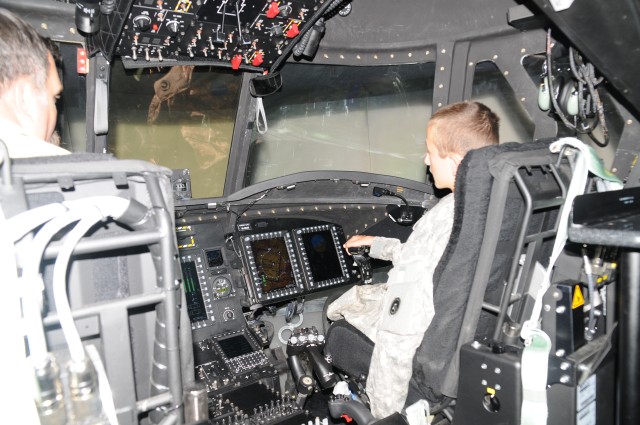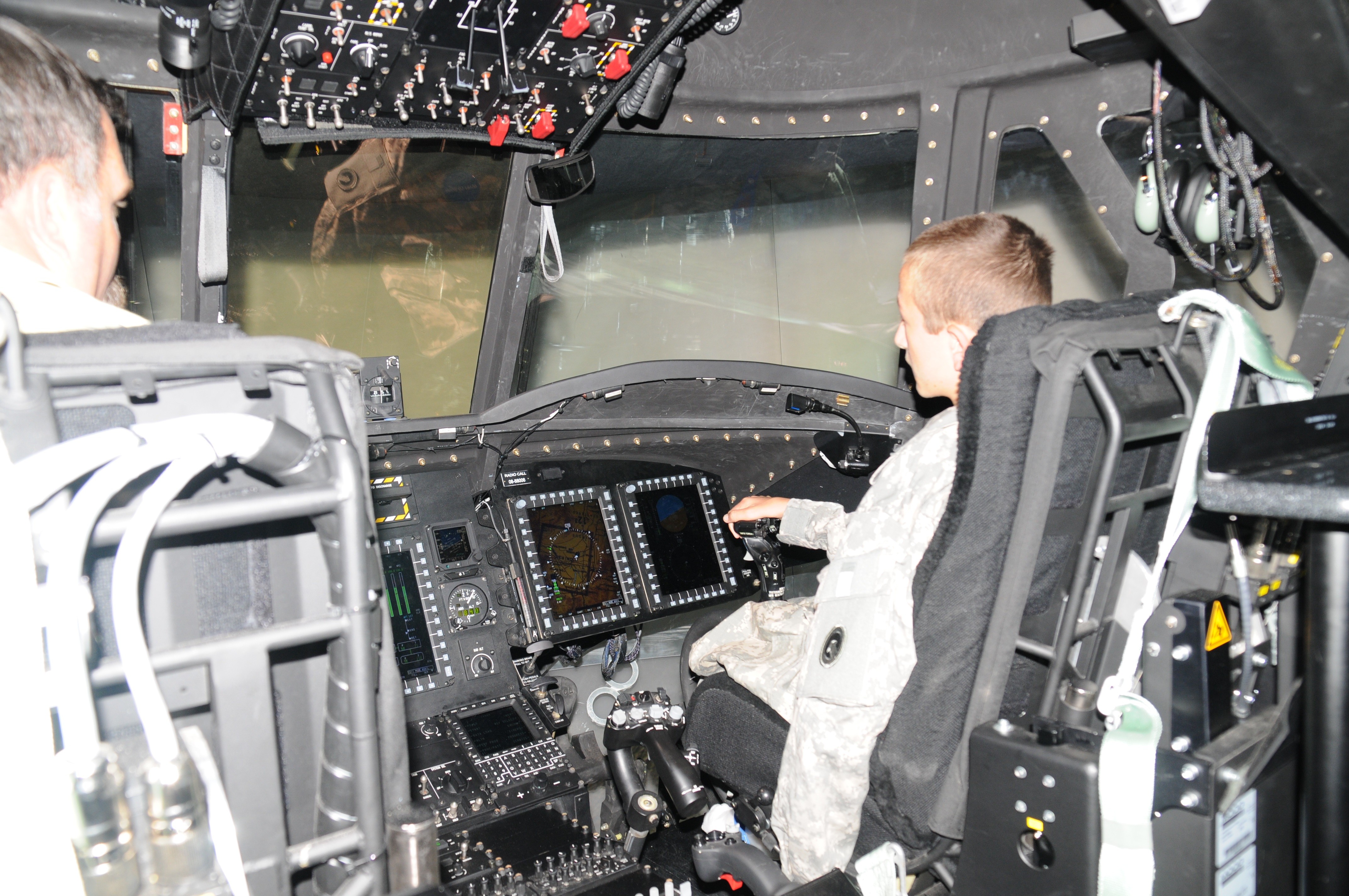
FORT BRAGG, N.C. - Even to the naked eye, there's a world of difference between the Sikorsky UH-60 Black Hawk and Boeing's AH-64D Apache aircraft.
The wider frame of a utility helicopter (like the Black Hawk) accommodates aeromedical evacuations, equipment relocation and the tactical transport of nearly a dozen battle-ready troops.
Not so with the Apache. One look at the tandem cockpit and slender frame of this helicopter will tell you this aircraft was built to attack. It's been called a flying tank - the most lethal aircraft ever created - but 1,000 feet over the deserts of Iraq or rocky outcrops of Afghanistan, it's often called the Army's best and brightest air assault weapon.
The twin-engine attack helicopter boasts AGM-114D Longbow Hellfire air-to-surface missiles, an advanced precision kill weapon system (70 mm rockets) and a 30-millimeter M230 chain gun mounted under the forward fuselage. It is said to fire 625 rounds a minute, or around 10 per second. Using avionics like long-wave infrared sensors, the Apache conducts day and night missions in nearly any topographic environment, making it a highly deployable attack aircraft.
"It's just pure awesomeness ... anybody that's ever flown it, I don't think they'd want to do anything else," said Chief Warrant Officer 2 Ken Welch, 1st Battalion, 82nd Combat Aviation Brigade, a gunner for the Apache.
Welch's battalion serves as the division's attack reconnaissance battalion.
After enlisting in the Army, Welch noticed the fleet of attack aircraft parked in the hangers at Simmons Army Airfield. Originally an engineer, he transferred to aviation and worked on the aircraft before becoming an aviation warrant officer.
"It's kind of hard to sit there and work on them and just watch them leave. You want to be part of the team," said Welch, who is preparing for another deployment this fall.
But training on multi-million dollar aircraft when you're half a world away from a Middle Eastern conflict can be tricky, to say the least. Regardless of the weaponry, such as missiles and rockets, learning the intricacies of the cockpit controls (and the layout of the land) can be a bit dangerous when first learning an aircraft.
To overcome this obstacle and in an effort to provide a valuable training source for the pilots who fly the Apache, the Boeing Corporation has created a simulator for the AH-64D Apache. It features a solid, two-trailer combination, which resembles an enclosed, mobile sound stage. Inside, the simulator houses a cockpit, which features separate aviator seats, complete with screens, and a vast computer system that connects a mass of hardware and software for prime operability.
Jack Dalton, an AH-64D instructor, explained the inner workings of the AH-64D simulator, as it is used for procedural training.
"We have a 98 percent fidelity to the aircraft," Dalton explained. "Once the pilot gets in, he is looking at the exact same thing he's looking at in the aircraft. Everything he touches is exactly the same way it is in the aircraft. So we're able to train them in systems they haven't seen before, prior to them getting in the aircraft."
Pilots are required to log 24 training hours a year, in the simulator, in addition to actual flight and range time. When training for a deployment, Apache pilots often log much more than the minimum, which keeps the simulator in high demand.
Throughout his or her Army career, an Apache pilot can easily receive over $1 million in aviation training.
"All pilots are required to demonstrate their ability to fire the weapons and do it safely in a simulator before they can get in an aircraft and pull the actual trigger," said Dalton, citing the cost of weapons as the reason. He pointed out that firing a real weapon system, during each training day, could easily put a sizeable dent in the defense budget. Hence, the 30mm round and its two-cent reputation as a computer-generated training tool (it costs just a few cents to simulate ammo).
Besides cost, the simulator provides a safe environment for learning new systems or demonstrating proficiency.
By using the system, problem areas are easily identified and resolved, and pilots can review their missions ... correcting mistakes if necessary.
"One of the things we look at is to make sure they're working together as a crew," said Dalton, who compared it to commercial airlines and their cockpit crew coordination trainings.
For Welch, who logged a training session on Dec. 28, 2010, one interpersonal skill is tantamount to crew coordination - whether simulating a covering force, escort or anti-armor operation. "Communication, without a doubt it has to be ... (of the utmost importance). We have elements of crew coordination but communicating is the biggest thing - always talking to the (other) guy," said Welch.
So whether a gunner is preparing to zero a weapon system or program the multifunction panels, he better ensure the pilot in command is also in the know.
C.J. Simmons is a longbow crew trainer instructor/operator who monitors pilots in the AH-64D simulator. He first flew the Apache into combat in Panama (operation "Just Cause" in 1989). According to Simmons, the role of a seasoned instructor is crucial to the simulator's success.
"We're able to pass along some of our past experiences (of what we've learned) onto those who haven't had much experience," Simmons said. "So they have an opportunity to learn from us, and we can also learn from them on how the battlefield is changing."
This interaction between ex-pilot and pilot and the understanding of lessons learned ensures that the pilots are being trained to standard, Simmons said, "(We can) make sure they train to a standard because we understand what those standards are," he said. "That way, they can leave home and come back home safely."
That protective nature comes naturally to an attack pilot, regardless of the situation. Chief Warrant Officer 2 Bill Hutchens, also assigned to 1-82 ARB, noted the simulator's effectiveness in mission readiness, which is crucial to keeping Soldiers on the ground safe.
"Guys who are on the ground, when they hear the Apaches overhead, they get a sense of, 'If something happens, these guys have (us covered)'," said Hutchens, who's been in the Army nearly 13 years.
Simulator training, according to Hutchens, is more fight than flight. "Anybody can get out there and fly it, that comes natural. The Apache, is built around having to execute - fighting is what makes you an Apache pilot."

Social Sharing